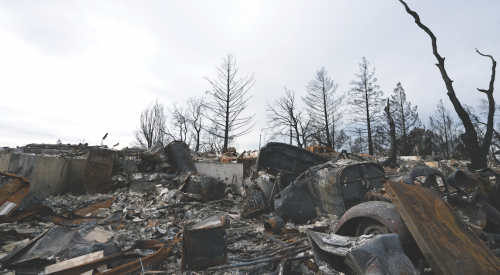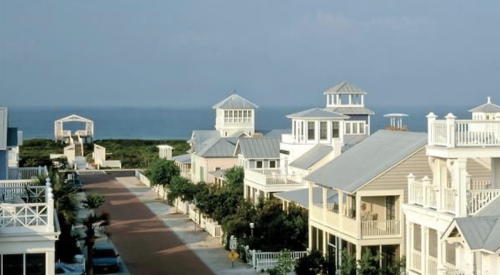|
 |
To hear architect Andrés Duany of Miami-based Duany Plater-Zyberk tell it, Coastal Mississippi is about to enter a reconstruction renaissance. At the same time, he says, New Orleans has been hamstrung by indecision and conflict.
"Every time they make a final plan in New Orleans, they retreat," Duany says. "Then they retreat again. I've never seen anything like it. They let five or six people come in who are vocal, and everything comes to a halt. You wouldn't design chewing gum based on the opinions of five or six people. How can you plan a city that way?"
In January, we filed a report about the prospects for a surge in home building in the New Orleans region ("No Man's Land"). Since then, construction activity has begun to pick up — not just in New Orleans, but all along the Southeast Coast — through Mississippi.
Mike Centineo, the Director of Safety and Permits for New Orleans whom we met with in November, says he expected a faster repopulation of the city.
"Hundreds of people come to our office every day," he says. "But we've got a long way to go. We assessed 91,000 properties and we're writing hundreds of permits for renovation, but not thousands."
Almost all of those permits, so far, have been for repair and renovation. But the trades — especially electricians and roofers are swamped. Estimates of total homes in the region either lost or heavily damaged total about 217,000.
"At first, we couldn't get labor," says Carl Lenczewski, a Detroit roofing sales rep who has been working in New Orleans, and is now moving to the region. "But now there are a lot of guys standing around without work. I'm talking about unskilled laborers. The contractors are all working, but they can't use any more inexperienced labor.
"There are scams everywhere, like you wouldn't believe," he adds. "Nobody's pulling permits. I've seen two pregnant women working on two separate roofs. Guys are putting their wives and their kids to work. I've seen some crazy stuff."
That labor problem is not unique to the Louisiana coastline. Further west, Mississippi is facing its own growing pains. Jason Spellings, a builder with ICON Artisan Builders in Jackson is planning to jump into the coastal rebuilding fray.
"I live three hours from the coast, here," he says. "Personally, my motivation is that I sat down with a group of 50- and 60-year old women from that area and listened to their stories. They're totally screwed. They're living in FEMA trailers and popups. They need help, and they don't know where to turn.
You drive down there, and you see more Chevy pickup trucks than you can count that don't have a tag," he adds. "It's just sick. A lot of these people coming down there don't know what the hell they're doing."
Spellings has carefully thought through how he can build economically on the coast, spending a few days of each week at home in Jackson. His solution: a narrow choice of plans, modular components and care and feeding of his framing crew. First, he has to create a base of operations. He was the first builder to construct one of the new "Katrina Cottages," so he's hoping to capitalize on that experience, and build a small selection of simple, New Urbanist-inspired homes.
Next on the agenda: acquiring land for scattered sites near the coast. Spellings figures the inflated labor costs on the coast will allow him to raise his own rates enough to cover travel and inconvenience.
"Pretty quickly we're going to have a reputation as somebody who does what we say will do, and does it well," he asserts. "Then we'll have plenty of work."
Perhaps the biggest difference between Mississippi and New Orleans, however, has been the fast-track application of New Urban master planning. While the Katrina Cottage may be getting the press, the bigger story is New Urbanism's leading role in shaping a vision of Gulf Coast renewal.
 |
|
Andrés Duany |
"Before we even arrived on the scene, there were about 60 high-rises in the permitting pipeline," notes Duany. We either had to build elsewhere or incorporate them into our plans."
Duany credits the top-down "get it done" leadership of Mississippi Governor Haley Barbour for allowing New Urbanist principles to become reality almost overnight in the region.
Barbour was not above twisting arms to get his way, either, Duany notes. The Governor dangled his discretionary funds over the heads of local planning officials. To get their share of the rebuilding money, they would have to sign on to a master plan with long-term design integrity (translation: New Urbanism).
Working without pay, DPZ led a successful effort to get 11 coastal towns to adopt ambitious plans, all of them rooted in New Urban principles. Other New Urbanism-friendly architectural firms such as Calthorpe Associates in Berkeley, Calif., and Urban Design Associates of Pittsburgh, also played a major role in the effort.
"This is what you might call a 'Perfect Storm' for adopting new technologies," notes Ben Brown, a new urbanism consultant based in Franklin, NC. "You can't just pick off one little thread. It all has to happen at once. For one Mississippi charette, we brought in sociologists, mass transit guys and the economic development people. They're all specialists but it all has to work together."
Marty Milstead, executive vice president of the Home Builders Association of Mississippi is working the practical end of the rebuilding equation: helping builders get their operations back together, and making sure they're well supplied. But he, too, is looking for something other than rough shelter.
"I think we can't just rebuild the coast," he says. "We've got to build it better, or we're doing ourselves a disservice."
Which technologies will leap to the foreground? "I think there's going to be an enormous, instant market for manufactured housing," Brown says. This will be good looking stuff with architectural detailing, he notes.
 |
|
Jason Spellings |
Spellings, the Jackson builder, is a devout believer in traditional neighborhood design principles. He suggests modular components with the right detailing will be an essential tool for rapidly creating traditional neighborhoods in many communities in southern Mississippi.
"The concept of traditional neighborhoods has been sold in 11 cities," he says. "It's going to be up to the private developer to make that promise a reality.
"We're hoping the big-shot tract builders will stay north of I-10," he adds, "and not come in and change the face of the landscape. If they want to build a cookie-cutter subdivision with three kids on bikes riding around on empty streets, they can do it out on some farmer's field."
Although locals have mixed feelings about out-of-state and out-of-town contractors, new arrivals don't always deserve a bad rap. Some are experienced builders, such as Rob Waldron, who is moving his family from Southern Maine to the New Orleans area because he sees years of lucrative work ahead.
"My two friends and I are looking into buying building that nobody wants to deal with, and renovating them," Waldron says. "We'd like to be able to hire people, but the licensing thing kills you down there. The big thing is that to get licensed, you need to have workers compensation for all employees. They want 49 cents for every dollar you pay, so we can't afford to hire anybody.
Despite the obstacles, there's plenty of evidence that contractors are flooding into the region. Most motels and hotels in the area are sold out.
Waldron notes that on one front at least, New Orleans is making good progress. "There are lots of demolition guys to hire, and some are actually pretty cheap. All you have to do is get the debris to the side of the road and the city will get rid of it. That's a major plus."
|














